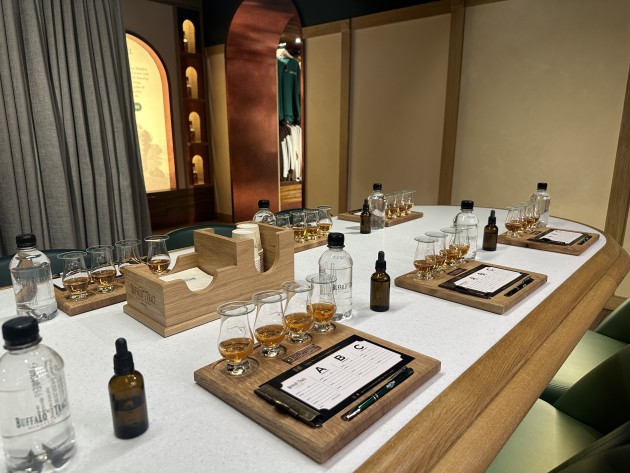
Sazerac Barrel Select: unique initiative set for UK launch
The US spirits company Sazerac will allow UK customers to partake for the first time in its barrel select programme. The initiative, which officially launches next Tuesday (18 March) will allow customers to hand-pick and purchase a barrel of one of Sazerac’s spirit brands, including their Buffalo Trace bourbon.
Since 2015, Sazerac has offered US customers the opportunity to buy single barrels with the current structure of the select programme having been launched in 2023.
At present the queue in the United States for the initiative is made up of 117,000 eager customers, though a select number of allocations will be made available for the UK launch, allowing customers to jump ahead of this queue. The launch is also the first overseas iteration of the Sazerac barrel select programme with other markets such as Australia potentially on the horizon.
At their UK launch event hosted at Buffalo Trace distillery London, Liam Sparks, prestige sales manager at Sazerac UK, explained how the barrel selection process works for a spirit chosen from Buffalo Trace’s distillery in Frankfort, Kentucky. Spirits made at the Frankfort distillery include Buffalo Trace bourbon, Eagle Rare bourbon and the cult favourite Pappy van Winkle bourbon.
Upon gaining the opportunity to select a barrel, customers will be invited to go to US to hand select their barrel from one of the many warehouses at the Buffalo Trace distillery in Kentucky. The opportunity to taste samples and select a barrel in the UK is also an option, with Liam Sparks guiding customers through this process if they decide to do so. After selecting their barrel, the precious liquid inside will be bottled and shipped to the UK and if customers so wish, they have the option of having their empty barrel shipped over too (customers have been known to use these barrels to create bespoke garden furniture).
At the launch, Liam Sparks and journalist Alice Lascelles guided us through a tasting of some of the bourbon drawn from select barrels at Buffalo Trace distillery. Sparks was keen to emphasise that although bourbons from Buffalo Trace distillery are typically blended, the barrel customers select is a unique expression of bourbon whiskey. Famed former master distiller at Buffalo Trace, Elmer T. Lee, concocted the idea of a modern brand single barrel bourbon, when he launched the Blanton’s bourbon in the 1980s.
Sparks demonstrated during the tasting, with three different barrel select bourbons from Buffalo Trace distillery, how bourbons aged in different warehouses (or rickhouses in bourbon speak), as well as in different parts of a given warehouse, produce vastly different flavour profiles.
The first barrel select bourbon we tried was one from warehouse U in Frankfort, which had the precise age, according to Sparks, of 8 years, 10 months and 11 days. Warehouse U has concrete flooring which means there is much less air flow between floors, creating a microclimate on each of the warehouse’s five floors. These ageing conditions afforded the bourbon with oak and coconut notes and an astringency which Sparks amusingly likened to licking the inside of a pencil case.
The second bourbon, aged for eight and a half years, was by a strong margin the favourite among attendees. The barrel was positioned on a lower floor of warehouse K, which afforded it cooler conditions, allowing it to age “low and slow”, as Sparks put it. The wooden floors of the warehouses allowed for greater airflow among the barrels, while its 219 windows allowed for further airflow as well as more sunlight. This ageing environment gave the bourbon more mellow, floral notes.
The final barrel select bourbon was from warehouse D and stored in the centre of the warehouse with much less direct sunlight. These differing ageing conditions once again gave the bourbon a vastly different flavour profile when compared to the first two.
The tasting diversity of bourbon was firmly on show during the tasting, highlighting the sophistication of the American whiskey. Those intrepid barrel purchasers from the UK who get to take part in the initiative, will gain a unique opportunity to select a bourbon that, thanks to the vast spectrum of ageing conditions, will probably be unlike any other.





